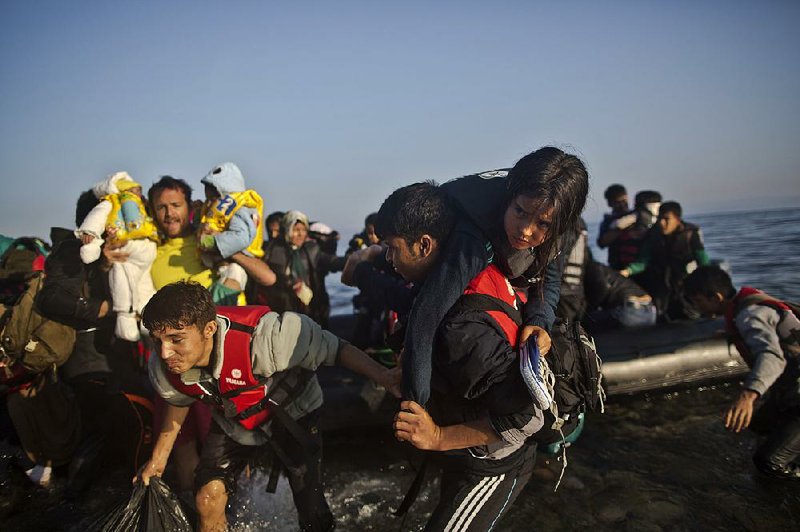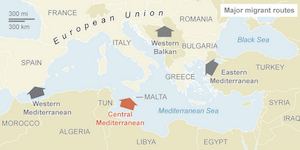ZAATARI REFUGEE CAMP, Jordan -- Growing numbers of Syrian refugees are returning to their war-ravaged homeland from Jordan because they can't survive in exile after drastic aid cuts, can't afford to pay smugglers to sneak them into Europe or are simply homesick.
Greece's coast guard said it rescued 1,743 refugees or migrants over the weekend in 57 separate search-and-rescue operations near eastern Aegean islands, and the body of a child was found washed up on an island beach.
Those rescued were picked up between Friday morning and Monday morning off the islands of Samos, Farmakonissi, Kos and Megisti, the coast guard said. They do not include those who make it to the islands themselves from the nearby Turkish coast, usually in overloaded inflatable dinghies.
Separately, the coast guard said late Sunday that the decomposing body of a child aged between 3 and 5 was found washed up on the island of Kos. It was unclear when the child, dressed in blue trousers and a pink top, had died.
The returns to Syria and the increasing migration to Europe signal that conditions in regional host countries have become increasingly intolerable, the refugees and aid officials said.
"We stopped getting any aid," said 47-year-old Adnan, waiting at the United Nations-run Zaatari refugee camp in northern Jordan to sign up his family for the return bus to the Syrian border, about 6 miles away. He only gave his first name for fear of repercussions from Syrian authorities.
The U.N. refugee agency views the rising number of departures with concern.
"It is a dangerous choice for people to make," said Andrew Harper, head of the U.N. refugee agency in Jordan. He said the return of refugees, mainly women and children, to war-torn Syria "signals a failure of the international protection regime."
More than 4 million Syrians fled civil war in their country, now in its fifth year. Most settled in Turkey, Lebanon and Jordan, a majority living in urban areas. Banned from working legally, they depend on aid and odd jobs. Recent aid cuts by underfunded agencies, particularly the World Food Program, have been devastating.
In Jordan, more than half a million urban refugees were hit hardest, while about 100,000 living in camps were not affected by the latest cuts.
Adnan and his family fled their village in the province of Daraa on the Jordanian border -- birthplace of the 2011 uprising against Syrian President Bashar Assad -- more than three years ago. They settled in Ramtha, a Jordanian city just a few miles from Daraa's provincial capital.
The family of 12 lived on food vouchers, while the two oldest sons sold vegetables to cover the rent of $250. Two months ago, all income dried up. The two oldest sons, their 14-year-old brother and a sister headed to Europe -- two are already in Sweden and two are still in Turkey -- while the family lost all food aid.
"There is no money," said Adnan, who plans to follow his children to Europe as soon as possible.
But the journey costs thousands of dollars, including $400 for a new Syrian passport that enables him to fly to Turkey without a visa, as well as a plane ticket and bribes for the smugglers. Adnan said he can't afford to pay for the rest of the family -- his mother, his wife, a six-year-old son, two daughters-in-law and two granddaughters.
On Thursday, he waited outside the U.N. office in Zaatari to register the women and children for return to Syria. The plan is for them to go back to their village of Seel and eventually reach Turkey overland. He shrugged when asked about the risks of travel in Syria, saying he simply had no choice.
In recent months, departures from Jordan by far outnumbered arrivals, and the outflow is increasing.
About 30 to 75 refugees enter Jordan every day, according to Hovig Etyemezian, the Zaatari camp's director.
By comparison, 3,853 refugees returned to Syria in August, compared to 1,934 in July, according to U.N. figures.
Harper said August saw the highest number of returns in 18 months -- the period during which multiple cross-border trips became largely impossible. He said departures fluctuated in the first half of 2015, but would not provide detailed figures. He said the number of September departures was lower than in August, but did not have the final tally. There was no bus traffic to the border for several days in September because of a major Muslim holiday.
It's not clear how many plan to stay in Syria and how many view it as a way station. Some refugees told U.N. officials that they plan to sell property so they can afford the journey to Europe. Others said they want to stay in their homeland.
More than 175,000 Syrian refugees from the region took the eastern sea route from Turkey to Greece between January and August of this year, while close to 7,000 traveled from North Africa to Italy, according to the International Organization for Migration. A total of close to 534,000 migrants reached Europe by sea during this period, the agency said.
Information for this article was contributed by Suzan Fraser, Bassem Mroue, Maeva Bambuck, Jamey Keaten and staff members of The Associated Press.
A Section on 10/06/2015

